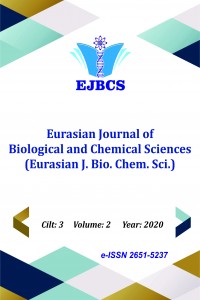Research Article
Abstract
References
- Akman, Y., Ketenoğlu, O., Kurt, L., & Vural, M. (2014). The steppe vegetation of Inner Anatolia.
- Arditti, J. (1992). Fundamentals of orchid biology. John Wiley & Sons.
- Ataşlar, E. Morpho-anatomical structure of Orchis mascula (L.) L. and its contribution to the taxonomy of Orchidaceae.
- Aybeke, M., Sezik, E., & Olgun, G. (2010). Vegetative anatomy of some Ophrys, Orchis and Dactylorhiza (Orchidaceae) taxa in Trakya region of Turkey. Flora-Morphology, Distribution, Functional Ecology of Plants, 205(2), 73-89.
- Baytop, T. (1997). Türkce bitki adlari sözlügü. Türk tarih kurumu.
- Davis, P.H. 1978. Flora of Turkey and The East Aegean Islands 8, Edinburgh Univ. Press, Edinburgh
- Dreesler, R.L.: Phylogeny and classification of the orchid family. Dioscorides Press, p. 314 (1993).
- Güner, A., Özhatay, N., Ekim, T., & Başer, K. H. C. (2000). Flora of Turkey and the east Aegean Islands. Supplement, 2, 28.
- Kreutz, C.A.J.: Orchidaceae. In: Flora of Turkey and the East Aegean islands (Eds.: A. Guner, N. Ozhatay, T. Ekim, K.H.C. Baser). Edinburg UniversityPress,Edinburgh, 11, 274 – 303 (2000).
- Kreutz, C.A.J.: Orchids of Turkey, Botanical Properties, Ecological Requirements, Natural Spreading Sites, Vital Threats, Precautions for Protection (Trans. & Cont.: A. Colak), Rota Publications, pp. 55-848 (2009).
- Renz, J., & Taubenheim, G. (1984). Dactylorhiza Necker ex Nevski. Flora of Turkey and the east Aegean islands, 8, 535-551.
- Renz, J. and G. Taubenheim: Orchis L. (Orchidaceae), In: Flora of Turkey and the East Aegean islands (Eds.: P.H. Davis) . Edinburgh, University Press, Edinburgh. 8, 451-600 (1984).
- Sevgi, E., Altundag, E., Kara, O., Sevgi, O., Tecimen, H. B., & Bolat, I. (2012). Morphological, anatomical and ecological studies on some Orchis (Orchidaceae) taxa of Mediterranean region, Turkey. Journal of environmental biology, 33(2), 343.
- Tuzlacı, E. (2006). Türkiye bitkileri sözlüğü: türkçe-latince, latince-türkçe; bitki adlarının özel açıklamaları. Alfa Basım Yayım Dağıtım.
- Vardar, Y. (1987). Botanikte preparasyon tekniği. Ege Üniversitesi, Izmir.
- Yue, T. L., Gu, J. L., Wang, C., Reith, A. D., Lee, J. C., Mirabile, R. C., ... & Ohlstein, E. H. (2000). Extracellular signal-regulated kinase plays an essential role in hypertrophic agonists, endothelin-1 and phenylephrine-induced cardiomyocyte hypertrophy. Journal of Biological Chemistry, 275(48), 37895-37901.
- Zarinkamar, F. (2006). Density, size and distribution of stornata in different monocotyledons. Pak J Biol Sci, 9, 1650-1659.
Morphological, anatomical and ecological studies on Orchis simia (Orchidaceae) taxon of Eskişehir, Turkey
Abstract
In this study, in the present study reveals the morphological, anatomical and ecological characteristic of Orchis simia Lam. in Turkey. Plant materials of Orchis L. species were collected from one population, between 2018 in Eskişehir/Turkey. Orchis simia samples were analyzed for 5 morphological, 6 anatomical and soil characters and habitat properties. In morphological investigations, the structure of flower, lateral sepal, petal, dorsal sepal, lip, anther cap and column was determined. The findings were compared with those in Flora of Turkey. to habitat definition, Orchis simia grew up to 800 m to 1100 m. Also, Quercus cerris forests and glades were most common habitat of Orchis simia, found generally over calcareous soils.
Keywords
References
- Akman, Y., Ketenoğlu, O., Kurt, L., & Vural, M. (2014). The steppe vegetation of Inner Anatolia.
- Arditti, J. (1992). Fundamentals of orchid biology. John Wiley & Sons.
- Ataşlar, E. Morpho-anatomical structure of Orchis mascula (L.) L. and its contribution to the taxonomy of Orchidaceae.
- Aybeke, M., Sezik, E., & Olgun, G. (2010). Vegetative anatomy of some Ophrys, Orchis and Dactylorhiza (Orchidaceae) taxa in Trakya region of Turkey. Flora-Morphology, Distribution, Functional Ecology of Plants, 205(2), 73-89.
- Baytop, T. (1997). Türkce bitki adlari sözlügü. Türk tarih kurumu.
- Davis, P.H. 1978. Flora of Turkey and The East Aegean Islands 8, Edinburgh Univ. Press, Edinburgh
- Dreesler, R.L.: Phylogeny and classification of the orchid family. Dioscorides Press, p. 314 (1993).
- Güner, A., Özhatay, N., Ekim, T., & Başer, K. H. C. (2000). Flora of Turkey and the east Aegean Islands. Supplement, 2, 28.
- Kreutz, C.A.J.: Orchidaceae. In: Flora of Turkey and the East Aegean islands (Eds.: A. Guner, N. Ozhatay, T. Ekim, K.H.C. Baser). Edinburg UniversityPress,Edinburgh, 11, 274 – 303 (2000).
- Kreutz, C.A.J.: Orchids of Turkey, Botanical Properties, Ecological Requirements, Natural Spreading Sites, Vital Threats, Precautions for Protection (Trans. & Cont.: A. Colak), Rota Publications, pp. 55-848 (2009).
- Renz, J., & Taubenheim, G. (1984). Dactylorhiza Necker ex Nevski. Flora of Turkey and the east Aegean islands, 8, 535-551.
- Renz, J. and G. Taubenheim: Orchis L. (Orchidaceae), In: Flora of Turkey and the East Aegean islands (Eds.: P.H. Davis) . Edinburgh, University Press, Edinburgh. 8, 451-600 (1984).
- Sevgi, E., Altundag, E., Kara, O., Sevgi, O., Tecimen, H. B., & Bolat, I. (2012). Morphological, anatomical and ecological studies on some Orchis (Orchidaceae) taxa of Mediterranean region, Turkey. Journal of environmental biology, 33(2), 343.
- Tuzlacı, E. (2006). Türkiye bitkileri sözlüğü: türkçe-latince, latince-türkçe; bitki adlarının özel açıklamaları. Alfa Basım Yayım Dağıtım.
- Vardar, Y. (1987). Botanikte preparasyon tekniği. Ege Üniversitesi, Izmir.
- Yue, T. L., Gu, J. L., Wang, C., Reith, A. D., Lee, J. C., Mirabile, R. C., ... & Ohlstein, E. H. (2000). Extracellular signal-regulated kinase plays an essential role in hypertrophic agonists, endothelin-1 and phenylephrine-induced cardiomyocyte hypertrophy. Journal of Biological Chemistry, 275(48), 37895-37901.
- Zarinkamar, F. (2006). Density, size and distribution of stornata in different monocotyledons. Pak J Biol Sci, 9, 1650-1659.
There are 17 citations in total.
Details
| Primary Language | English |
|---|---|
| Subjects | Structural Biology |
| Journal Section | Research Articles |
| Authors | |
| Publication Date | December 29, 2020 |
| Acceptance Date | December 6, 2020 |
| Published in Issue | Year 2020 Volume: 3 Issue: 2 |
Cite

